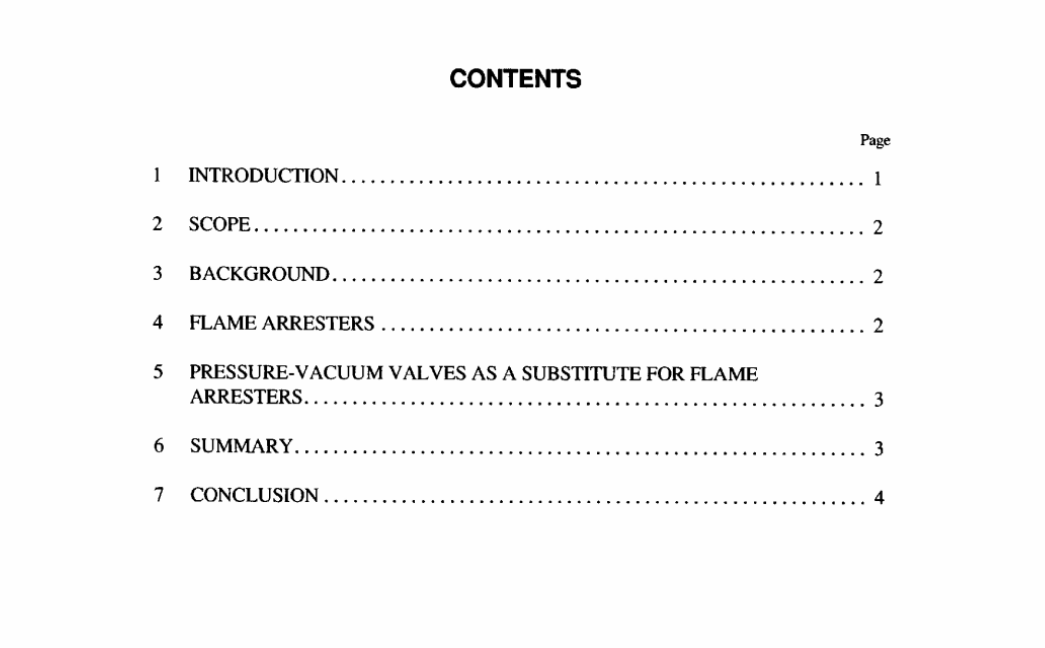API RP 2210 pdf download

API RP 2210 pdf download.Flame Arresters for Vents of Tanks Storing Petroleum Products
1 Introduction
1.1 In addition to connections for liquid entry and with- drawal, every atmospheric fixed-roof tank requires a vent that allows escape or entry of air and/or vapors to avoid develop- ment of pressure or vacuum conditions sufficient to damage the tank during liquid transfer or changes in ambient condi- tions. This publication discusses the benefits and detriments associated with the use of fame arresters on these vents. 1.1.1 The provisions of this publication are intended for use when designing new facilities or when considering major expansions. It is not intended that the recommendations in this publication be applied retroactively to existing facilities. This publication also can be used as guidance when there is a need or desire to review existing facilities. 1.2 NFPA 30, Flammable and Combustible Liquids Code, lists requirements for tank vents in which flammable and combustible liquids are stored. API Standard 2000, Venting Atmospheric and Low-Pressure Storage Tanks, and NFPA 30 cover the size and venting capacity to accommodate normal and emergency conditions of the tanks. Devices that are nor- mally closed, except when operating under pressure or vac- uum conditions, are often called pressure-vacuum valves. Such valves are normally required for flammable liquids (see NFPA 30). Additional information on vents and pressure-vac- uum valves can be found in API Standard 620, Design and Construction of Large, Welded Low-Pressure Storage Tanks, and API Standard 650, Welded Steel Tanks for Oil Storage. Under certain circumstances, fame arresters listed by the Underwriters’Laboratories or approved by the Factory Mutual Engineering and Research Corporation are used in conjunction with, or in lieu of, a pressure-vacuum valve. The publications cited are considered standards for good practice, and may be incorporated in mandatory codes or ordinances in some jurisdictions.
3 Background
3.1 In the early history of the petroleum industry, when storage tanks were constructed of wood or wrought iron with wooden roofs, there were spectacular losses from tank fires. Lightning or other ignition sources that ignited vapors in (or escaping from) the tank usually caused the tank fires. The permeability and combustible nature of wooden roofs con- tributed to the start and magnitude of the fires. 3.2 The losses caused by fires and the evaporation of crude oil and gasoline in wooden-roof tanks contributed to the development and use of riveted steel- roof tanks. The tightness of the riveted steel-roof tanks led to the need for controlled tank venting. The use of a valve that remains tightly closed during periods when the tank internal pressure is within spec- ifed limits but that promptly opens when pressure or vacuum exceeds those limits can prevent tank damage and reduce fire losses. This valve, initially known as a breather valve, is now more commonly known as a conservation vent or a pressure- vacuum (PV) valve. 3.3 As steel-roof tanks began to replace wooden ones, it was noted that lightning-caused fires continued to occur in tanks with wooden roofs, but tanks with steel roofs were vir- tually immune to lightning caused fires. Based on this experi- ence, steel-roof tanks were selected for the storage of volatile stocks. Such tanks were usually equipped with pressure-vac- uum valves as a measure to reduce evaporation loss. A 1925 API committee report documented the fact that the combina- tion of a tight steel roof and a pressure-vacuum valve gave virtully complete protection against lightning -caused fires; the use of this combination in the ensuing years has con- fimmed this report.









